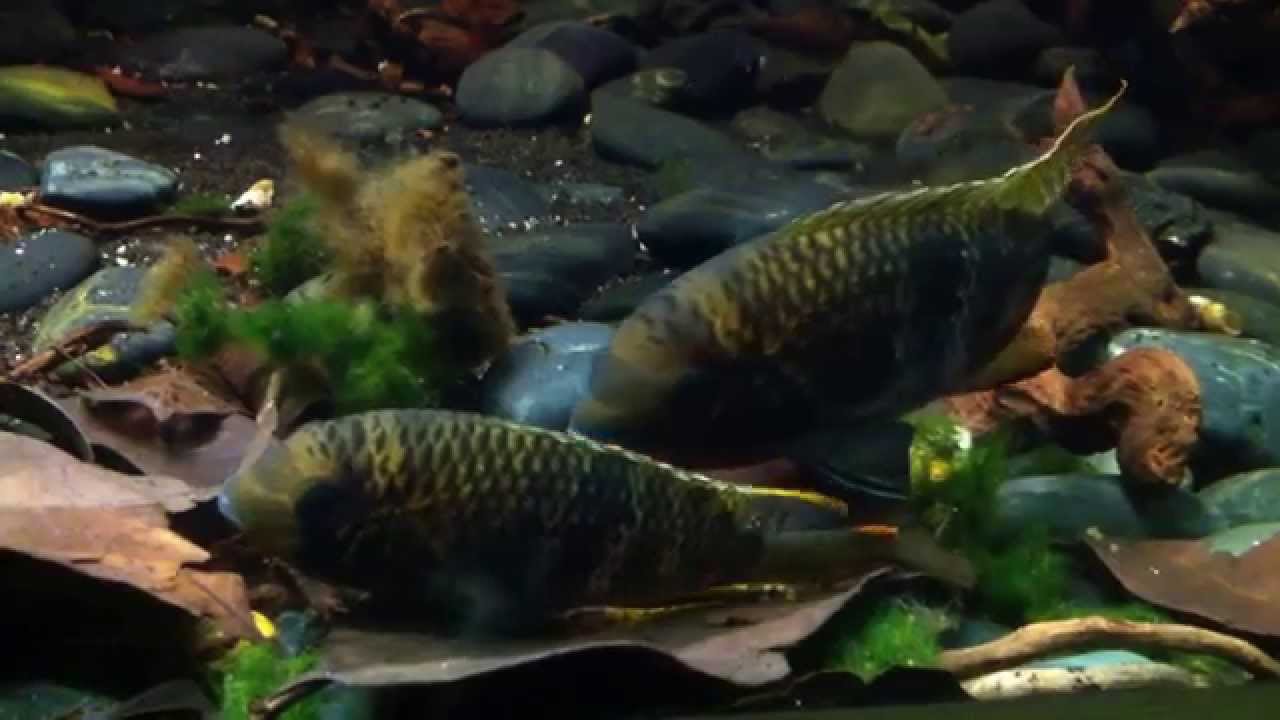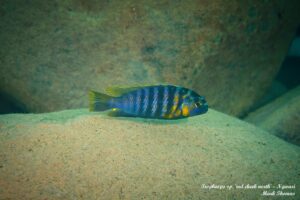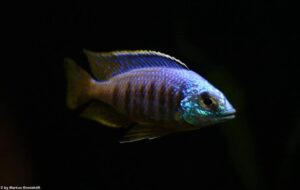Andinoacara biseriatus
Andinoacara biseriatus was first described in 1913 by Regan, then as Cichlosoma (Aequidens) biseriatum, The genus name Andinoacara can be broken into two parts. “Andino” refers to the Andes Mountains where the habitat of this genus is located. “Acará” is the word for cichlids in the local language of the Tupí-Guaraní. The species name biseriatus can be broken into two parts. “bi” means “two.” “seriatus” means “rows.” This is not explained in the description but presumably a reference to dark longitudinal stripes or rows of spots on the scales of the flank.
This species has two synonyms: Aequidens biseriatus and Cichlasoma biseriatum.
Description
The length of the Aninoacara biseriatus male and female are somewhat different. The male can reach a maximum total length of about 12 centimeters. The female remains slightly smaller at 10 centimeters.
The male and female look almost identical in this species. However, the male is usually more intensely colored than the female. Also, the dorsal and anal fins are a bit more elongated in the male than in the female.
The color is dark with light spots on the scales. Over the flank run two dark horizontal bands or rows of dark spots. Sometimes they also have vertical dark bands.
The lips and pelvic fins are trimmed with a small iridescent blue margin. The upper edge of the dorsal fin has a colored stripe that ranges from white to orange, this edge continues into the upper edge of the caudal fin. In the dorsal fin, against the back, a black spot is present between the 10th and 12th fin rays. This is also called ocellus (by-eye). Sometimes a second spot is present; it can be located either in front or behind the by-eye.
Rivulatus group
Andinoacara biseriatus is not very similar to the other species within the Andinoacara genus. However, they are closely related to Andinoacara rivulatus and Andinoacara stalsbergi. They are therefore placed in the Rivulatus group.
Biotope
Andinoacara biseriatus is found only in Colombia. There they inhabit the Rio Atrato, Rio Baudó and Rio San Juan basin.
Diet
This is an omnivore. Thus, they eat both animal and plant foods. Therefore , the diet must be appropriate to that.
Give them a variety of flake food or granules for omnivorous fish. You can alternate this with, for example, peas and spinach as green food. Live or frozen food is also eagerly eaten. Consider white and black mosquito larvae, artemia, pieces of mussels, shrimp, worms and the like.
Do not give the fish more than they can eat in a few minutes. Food left lying around pollutes the water very quickly!
The Aquarium
The dedicated aquarium for a pair of Andinoacara biseriatus should be at least 120 centimeters long but preferably a bit larger. As the fish get older, they tend to become a bit more territorial. If you want to combine them with other fish species in the same water layer, an aquarium from 150 centimeters in length is recommended.
Furnish the aquarium with gravel or sand on the bottom. Use wood and pebbles to create hiding places. In their biotope , plants do occur on the banks. You can also placethese at the edge of the aquarium.
Water parameters
The water in which Andinoacara biseriatus is found is somewhat acidic and soft. Keep the pH preferably between 5. 0 and 6.5. As mentioned , they like soft water with a GH below 5. The temperature may be a bit higher for this species, think of 24 to 29 degrees Celsius.
What species can you combine Andinoacara biseriatus with ?
When picking co-inhabitants for Andinoacara biseriatus, you should keep in mind that they are strong territorial cichlids. It is best to combine them with the somewhat larger Carp Salmon, for example. An example is the Bleeding Heart Tetra. On the bottom you can keep some Corydoras just fine. Species of the family Loricariidae, of sufficient size, are also fine.
How old can Andinoacara biseriatus become?
With proper care and proper water composition , Andinoacara biseriatus can reach an age of about five to six years.
Breeding Andinoacara biseriatus
From a length of about eight to nine centimeters, Andinoacara biseriatus can reproduce. In doing so, they form a monogamous pair.
Around a burrow or a flat stone they form their territory. The stone is completely cleaned by the couple. In the absence of a suitable stone or location, they also lay the eggs on the gravel. Although little difference can be seen between the sexes, the female becomes very dark, to almost black in color when laying the eggs.
The female lays about 75 to 150 eggs that are directly fertilized by the male. The female cares for the eggs until they hatch after two to three days. The male guards the area and chases away all other fish.
The newly hatched fish are constantly being moved so they can feed on microorganisms. After about seven days they can swim on their own. Both parents protect the young fish for a long time.
You can feed the young Andinoacara biseriatus with crushed flake food and newly hatched artemia.
Conclusion
Andinoacara biseriatus is not the largest or most colorful species within the genus. What they lack in bright colors and size, they more than make up for with their behavior. They are interesting fish that are not too large or aggressive and therefore can be well kept in an aquarium. With some luck, you can watch them raise a litter of young!
Video
Author
John de Lange
Copyright images
Erik Bakker – Aqua-specials.nl
References
C. Tate Regan M.A. (1913) LVI.—The fishes of the San Juan river, Colombia, Annals and Magazine of Natural History, 12:71, 462-473, DOI: 10.1080/00222931308693424
Fishbase
Andinoacara.com
Etyfish
Housaqua.com
Aquaportail










